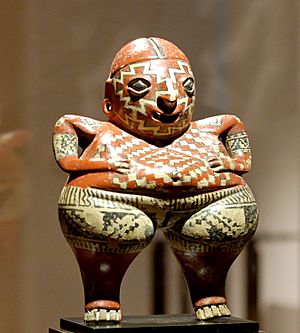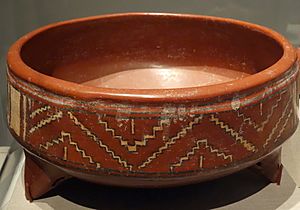Chupícuaro facts for kids
| Name: | Chupícuaro |
| Location | Nuevo Chupicuaro, Guanajuato |
| Coordinates | 20°01′20″N 100°35′29″W / 20.02222°N 100.59139°W |
| Culture | Chichimec - Toltec |
| Period | Preclassical Mesoamerican Period |
| Language | Purépecha language |
| INAH Official Page | Not available |
Chupícuaro is an important ancient site in Mexico. It comes from a time called the late Preclassical or Formative period. The culture named after this place existed from about 400 BC to 200 AD. Some experts think it might even be older, starting around 800 BC.
Chupícuaro is located in Guanajuato State, Mexico. It's close to the Valley of Mexico and the northern edge of Mesoamerica. This area is near the Lerma River. Most of the original site was flooded in the 1940s when the Presa Solis dam was built. Before the flooding, the INAH (Mexico's National Institute of Anthropology and History) managed to save some artifacts. More excavations have happened since 1998, helping us learn more about the Chupícuaro culture.

Contents
What Does Chupícuaro Mean?
The name Chupícuaro means "blue place." It comes from the Purépecha language. "Chupicua" is the name of a plant (like the Ipomoea plant) that was used to make blue dye. The word "ro" means "place."
A Look into Chupícuaro's Past
This ancient site is found along the Lerma River, between the cities of Acámbaro and Tarandacuao in Guanajuato. We don't know a lot about its full history. The first digs happened in 1946, where people found pottery and tombs. Today, the main site is underwater because of the dam. However, archaeologists are still exploring the areas around it.
Nomadic groups, like the Chichimeca people (Guamares and Guachichil), arrived in this region from what is now San Luis Potosí state.
These groups settled in a large village. They built huts on platforms made of mud and stone. They were farmers who grew corn, beans, and squash near the Lerma River. They also used tools like molcajetes (stone grinders) for corn, suggesting they might have grown chili and tomatoes. We also know they hunted, fished, and gathered food.
Experts believe this settlement grew between 500 BCE and 300 CE. The first people here were hunter-gatherers who learned how to farm over time.
In 2013, the water level behind the dam dropped for a short time. This allowed archaeologists to move the towers from the old church to the town of Nuevo Chupicuaro. This new town was founded in 1946 when the original Chupícuaro town had to move because of the dam.
What the Site Looks Like

The Chupícuaro culture developed between 500 BCE and 300 CE. Some scientists think it might have started even earlier, around 800 BCE.
There's another site called Ibarrilla in Leon, Guanajuato, which is thought to be part of the Chupícuaro area. It might be one of the largest and most important sites in the country. People believe there are more than a dozen pyramids built on oval bases there. Only one has been partly explored, revealing flint stone objects, figurines, and pottery.
Many other structures, tombs, and altars are still waiting to be explored in an area estimated to be about 500 square meters.
The Chupícuaro Culture
This culture was very important because it influenced a large area. Its influence might have reached as far as the southern United States around 500 BCE. Some theories suggest that the first people in Guanajuato belonged to this culture.
The pottery from Chupícuaro is older than the main classical period in Mesoamerica. It includes unique figurines with angular shapes and geometric designs. The museum in Acámbaro has many pieces from the Chupícuaro, Purépecha, Mazahua, and Otomi cultures.
The Chupícuaro culture or "style" spread across a huge territory. This included parts of Guanajuato, Michoacán, Guerrero, Mexico State, Hidalgo, Colima, Nayarit, Querétaro, and Zacatecas. It's believed that Chupícuaro helped spread Mesoamerican ideas and culture northward.
Chupícuaro had a big impact on pottery styles in distant areas. Its influence lasted even into later periods, like the Postclassical era, seen in Purépecha pottery.
In the 1980s, experts agreed that the groups making Chupícuaro pottery were part of organized societies. They had political structures and territories, not just small, isolated villages. This early culture laid the groundwork for other important cultures in Mesoamerica.
Cultures in the Acámbaro Region
The Acámbaro area was home to five main ancient cultures:
- Chupícuaro: From the Late Preclassical period (800 BCE to 200 CE).
- Los Morales: Also Late Preclassical (400 BCE to 250 CE).
- Teotihuacán: From the Classical Period (200 CE to 900 CE).
- Toltec: From the Early Postclassical period (900 CE to 1200 CE).
- Purépecha: From the Late Postclassical period (1200 CE to 1525 CE).
Pottery from Chupícuaro
Chupícuaro was famous for its pottery. It's known as some of the best in Mesoamerica. The pottery had beautiful finishes and decorations. They made many different shapes and used various colors, often with geometric patterns. The designs showed gods, mothers, babies, people with their jewelry, animals, and plants.
Their pottery included simple single-color pieces and colorful ones with three colors: red, beige, and black. These often had pyramid shapes or zig-zags. They also made clay figurines using a technique called "pastillaje" and created hollow figures. They used materials like shell, bone, and stone for other items.
By studying their pottery, we can guess what they wore. They painted their faces and bodies, wore sandals, necklaces, and earrings. Women often had fancy hairstyles.
Burial Customs
The people of Chupícuaro had special customs for burying their dead. In their tombs, archaeologists found many items. These included trophy skulls, obsidian arrowheads, metates (grinding stones), figurines, shell ornaments, necklaces, beads, bone tools, and musical instruments. These items were found during excavations around 1950.
These many burials and offerings teach us a lot about how the ancient Chupícuaro people lived. They were farmers who lived in huts made from materials that don't last long. They formed a large rural village with low platforms and clay floors, where their houses were built. They grew corn, beans, and pumpkins.
See also
 In Spanish: Chupícuaro (asentamiento prehispánico) para niños
In Spanish: Chupícuaro (asentamiento prehispánico) para niños



